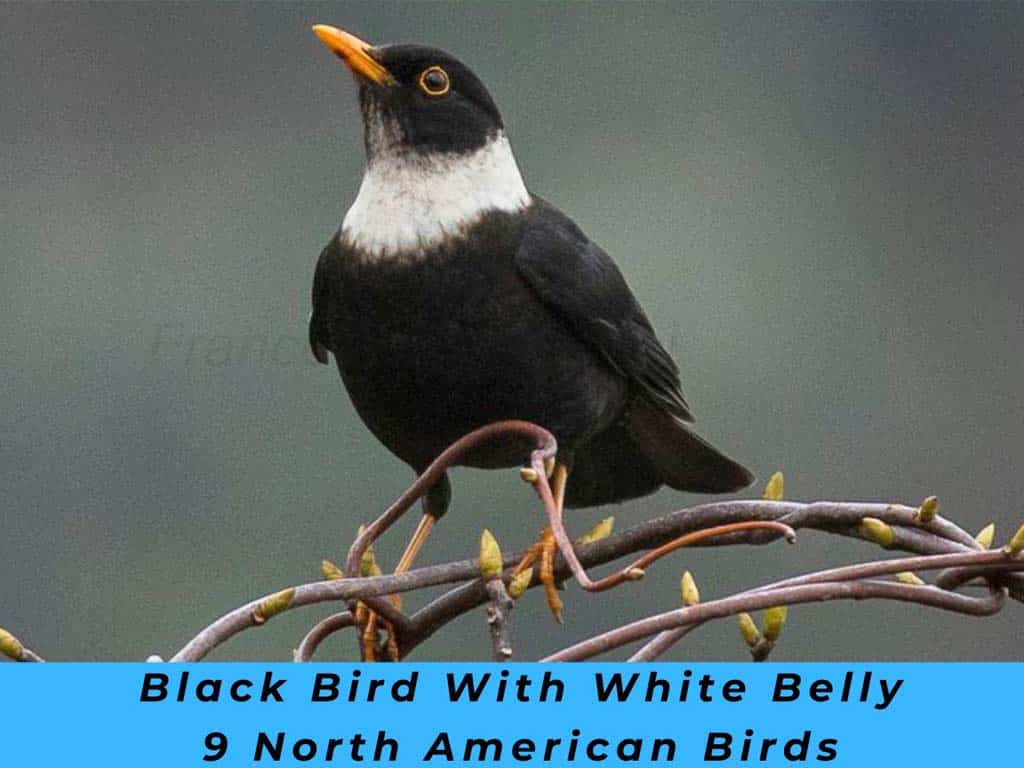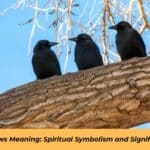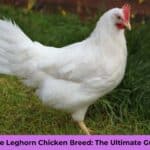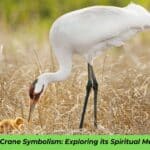Have you ever spotted a black bird with white belly flitting through your backyard or local park?
These striking creatures, with their bold contrast of dark and light plumage, aren’t just eye-catching—they’re fascinating examples of nature’s ingenuity.
In this comprehensive guide, we’ll explore nine captivating North American bird species that share this distinctive coloration, delving into their unique characteristics, behaviors, and the important roles they play in our ecosystems.
The Science Behind Black Birds with White Bellies: Nature’s Color Scheme
Before we meet our feathered friends, let’s unpack why so many birds sport this striking color combination. It’s not just about looking dapper—there’s some serious science behind it.
Countershading: How Black Birds with White Bellies Blend In
Countershading is a clever form of camouflage that helps birds blend in with their surroundings when viewed from different angles. Here’s how it works:
- From above: The dark upper parts mimic shadows, helping the bird blend in with the ground.
- From below: The light underparts match the bright sky, making the bird less visible to predators looking up.
This adaptation is particularly useful for birds that need to avoid both aerial predators and ground-based threats.
Beyond Camouflage: Other Advantages of Black and White Plumage
But there’s more to black and white plumage than just hiding from predators:
- Thermoregulation: Dark feathers absorb heat, while light feathers reflect it, helping birds maintain optimal body temperature in various environments.
- Mate attraction: In some species, the stark contrast can be a signal of genetic fitness, helping birds find the best partners.
- Species recognition: The distinctive patterns help birds quickly identify members of their own species, which is crucial for social interactions and breeding.
Now that we understand the “why” behind these striking color patterns, let’s meet our nine North American stars.
Flycatchers: Aerial Acrobats with Black Bodies and White Bellies
Eastern Kingbird: A Regal Black Bird with White Belly
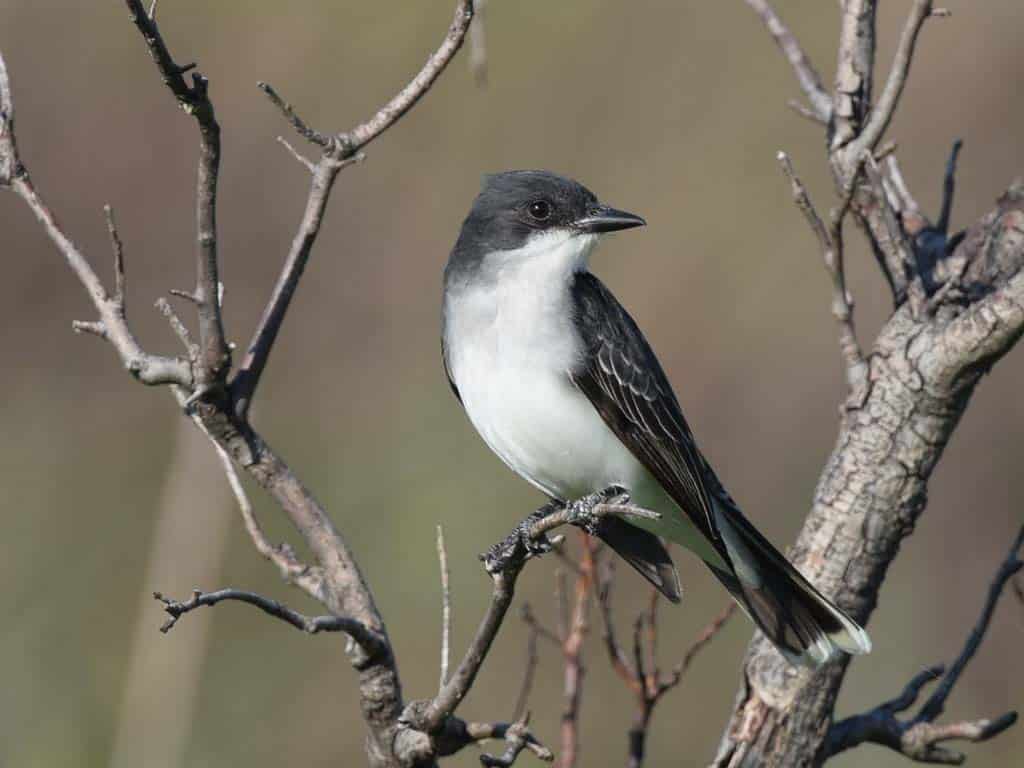
The Eastern Kingbird is the avian equivalent of a fighter pilot, known for its aggressive aerial pursuits of insects and even larger birds that dare to enter its territory.
Key Features:
- Length: 7.5-9 inches
- Wingspan: 13-15 inches
- Weight: 1.2-1.9 ounces
This monomorphic species sports a sleek, dark black upper body that contrasts sharply with its bright white underparts. A distinctive white band at the tip of its tail gives it a regal appearance, befitting its “kingbird” moniker.
“The Eastern Kingbird’s scientific name, Tyrannus tyrannus, refers to its fierce territorial behavior, often taking on much larger birds to defend its domain.” – John James Audubon
Habitat and Distribution: Eastern Kingbirds prefer open habitats like fields, orchards, and forest edges. They’re migratory species, breeding across much of North America and wintering in South America.
Fun Fact: Despite their small size, Eastern Kingbirds have been observed chasing away birds as large as hawks and crows from their territories. Talk about punching above their weight class!
Check this out Herons In Michigan – The Complete Guide To 8 Michigan Herons
Black Phoebe: The Tail-Wagging Black Bird with White Belly
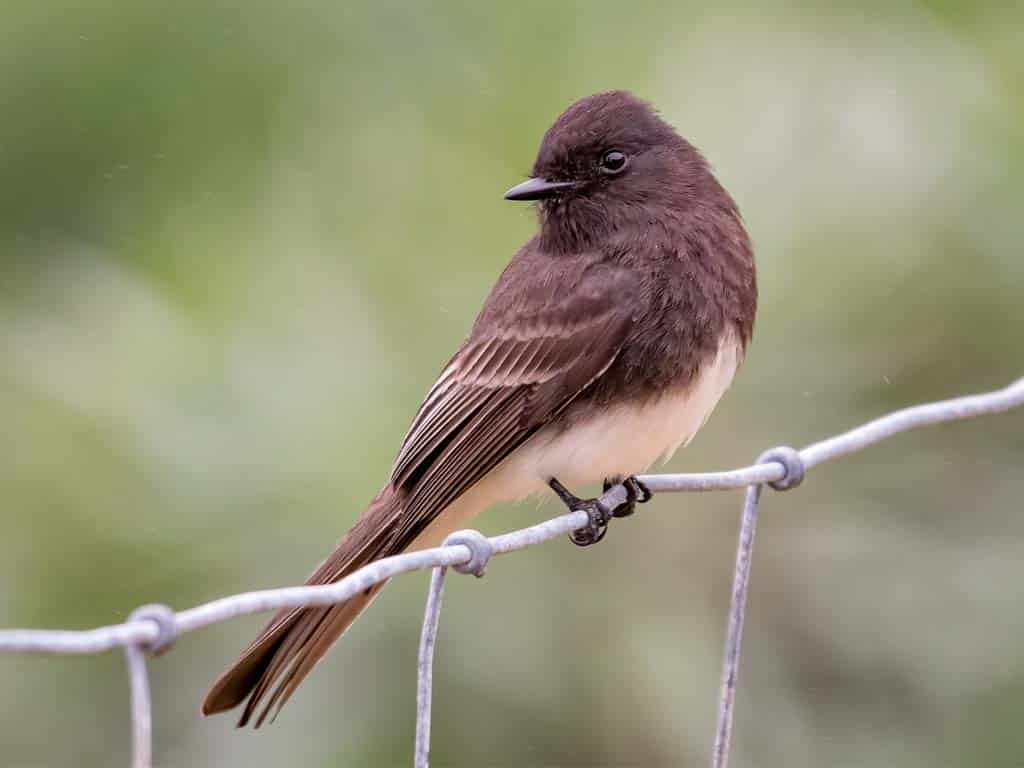
The Black Phoebe is a charismatic flycatcher known for its distinctive tail-wagging behavior and adaptability to human environments.
Key Features:
- Length: 6-7 inches
- Wingspan: 10-11 inches
- Weight: 0.5-0.8 ounces
With its sooty black upper parts and crisp white belly, the Black Phoebe is a study in contrast. Its habit of repeatedly dipping its tail makes it easy to spot even from a distance.
Habitat and Distribution: Black Phoebes are often found near water sources in the western United States, Mexico, and parts of South America. They’ve adapted well to urban and suburban environments, often nesting on human structures.
Vocalizations: The Black Phoebe’s call is a distinctive, repeated “fee-bee,” which it uses to establish territory and communicate with mates.
Sparrows: Ground-Dwelling Black Birds with White Bellies
Dark-eyed Junco: A Variable Black Bird with White Belly

The Dark-eyed Junco is a winter favorite at bird feeders across North America, known for its variability in plumage across different regions.
Key Features:
- Length: 5.5-6.3 inches
- Wingspan: 7.1-9.8 inches
- Weight: 0.6-1.1 ounces
While all juncos have white outer tail feathers and white bellies, their upper body color can range from slate-gray to brown, depending on the subspecies.
Regional Variations:
| Subspecies | Region | Upper Body Color |
| Slate-colored Junco | Eastern North America | Dark slate-gray |
| Oregon Junco | Western North America | Brown to black hood |
| White-winged Junco | Black Hills region | Dark slate with white wing bars |
| Pink-sided Junco | Rocky Mountains | Gray with pinkish flanks |
Migratory Patterns: Most juncos breed in Canada and the northern United States, migrating south for the winter. Some populations in the west are year-round residents.
Check this out How Long Does a Quail Live? The Vulnerable Lives Of Quail
Harris’s Sparrow: North America’s Largest Black Bird with White Belly
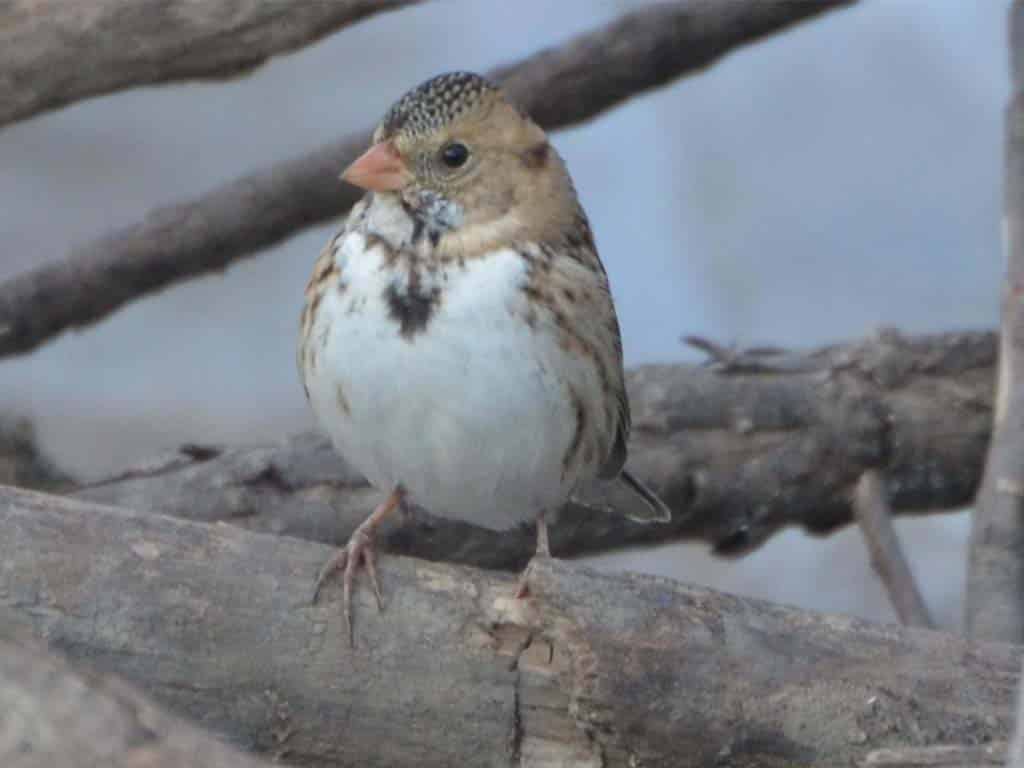
The Harris’s Sparrow holds the title of North America’s largest sparrow and is known for its distinctive black bib and crown.
Key Features:
- Length: 6.7-7.9 inches
- Wingspan: 10.6 inches
- Weight: 0.9-1.7 ounces
Adults in breeding plumage sport a black crown, face, and bib, contrasting with their white belly and brown-streaked back.
Unique Breeding Grounds: Harris’s Sparrows are the only songbird that breeds exclusively in Canada, favoring the transition zone between boreal forests and arctic tundra.
Conservation Status: While not currently threatened, Harris’s Sparrows face challenges due to climate change affecting their breeding habitats.
Eastern Towhee: A Striking Black Bird with White Belly

The Eastern Towhee is a striking sparrow known for its distinctive “drink-your-tea” call and ground-foraging habits.
Key Features:
- Length: 6.8-8.2 inches
- Wingspan: 7.9-11 inches
- Weight: 1.1-1.8 ounces
Males sport a bold black upper body with rusty sides and a white belly, while females replace the black with a rich brown.
Foraging Habits: Eastern Towhees use a unique double-scratch method to uncover food, jumping backward to scatter leaves and expose insects and seeds.
Habitat Preferences: These birds favor edge habitats, thickets, and overgrown fields, where they can easily hide in dense vegetative cover.
Spotted Towhee: The Western Black Bird with White Belly
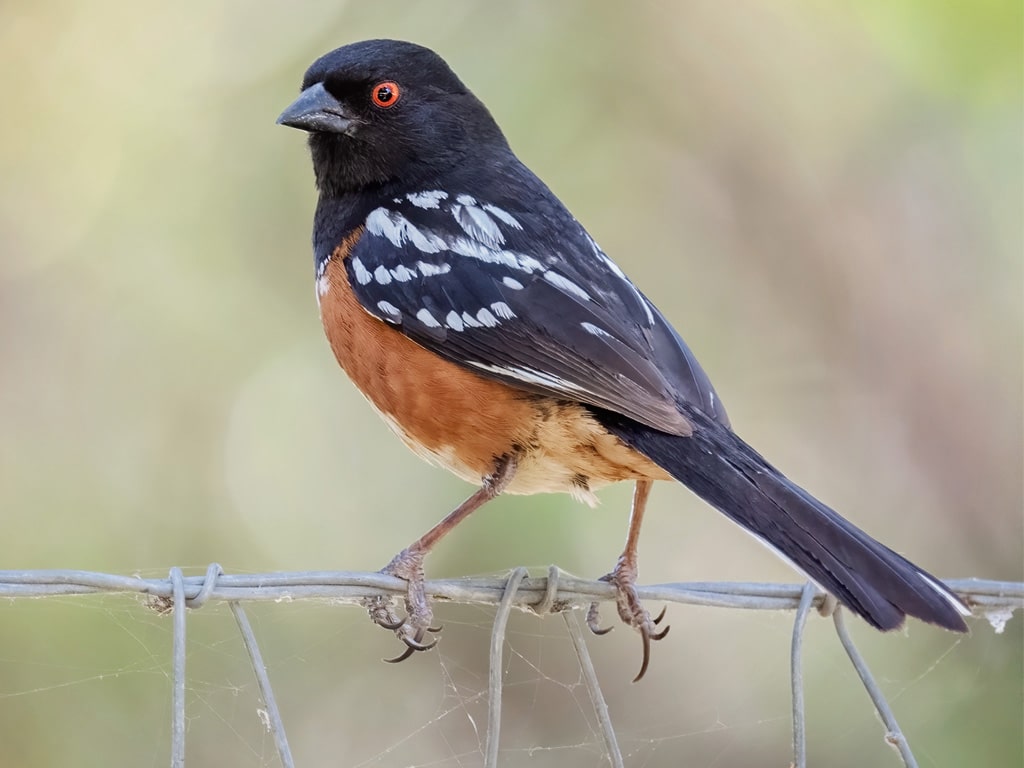
The Spotted Towhee is the western counterpart to the Eastern Towhee, sporting similar coloration with the addition of distinctive white spots on its wings and back.
Key Features:
- Length: 6.7-8.3 inches
- Wingspan: 11 inches
- Weight: 1.2-1.7 ounces
Like its eastern cousin, the Spotted Towhee has a black (or brown in females) upper body, white belly, and rusty sides. The white spots on its wings and back set it apart.
Habitat Preferences: Spotted Towhees favor chaparral, forest edges, and brushy areas in the western United States and parts of Canada.
Interesting Nesting Behavior: These birds often build their nests on or near the ground, cleverly concealing them in dense vegetation.
Check this out Do Crows Eat Other Birds? The Disturbing Truth
Warblers: Jewels of the Forest with Black and White Plumage
Black-and-white Warbler: The Striped Black Bird with White Belly
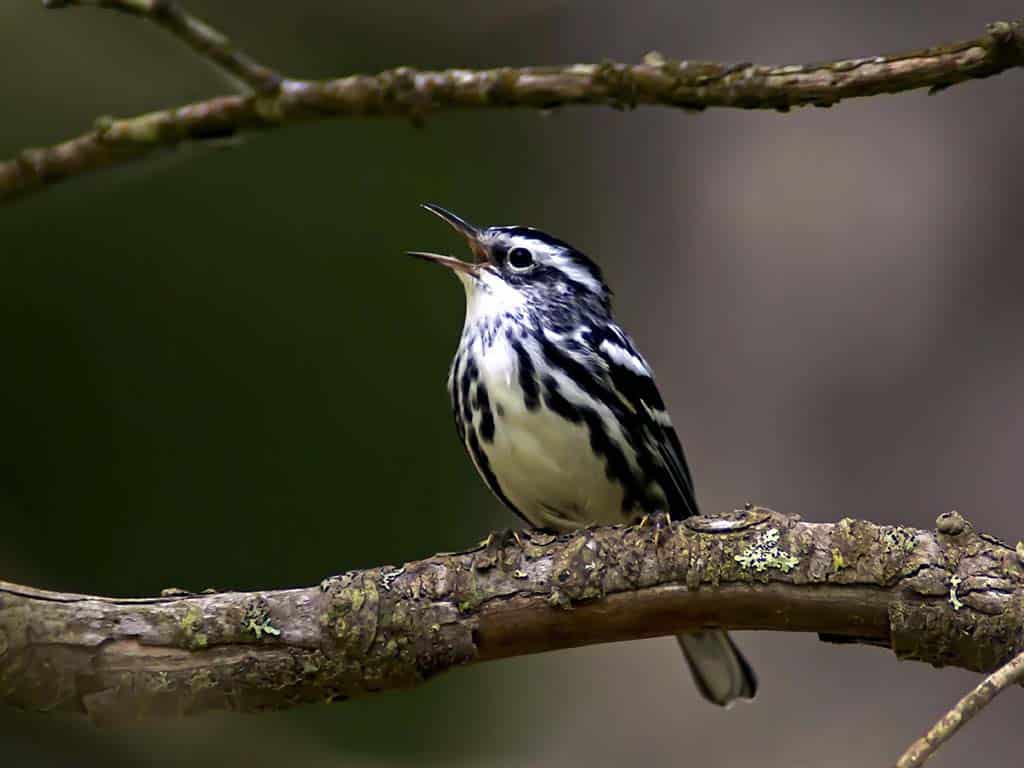
The Black-and-white Warbler is a study in contrasts, with its boldly striped plumage and unique foraging technique.
Key Features:
- Length: 4.3-5.1 inches
- Wingspan: 7.1-8.7 inches
- Weight: 0.3-0.5 ounces
As its name suggests, this warbler is covered in bold black and white stripes, making it one of the most distinctively patterned warblers in North America.
Unique Foraging Technique: Unlike most warblers that glean insects from leaves, the Black-and-white Warbler creeps along tree trunks and branches, much like a nuthatch or creeper.
Migration Patterns: These warblers breed in deciduous and mixed forests across eastern North America and winter in the Caribbean, Central America, and northern South America.
Blackpoll Warbler: A Migratory Black Bird with White Belly
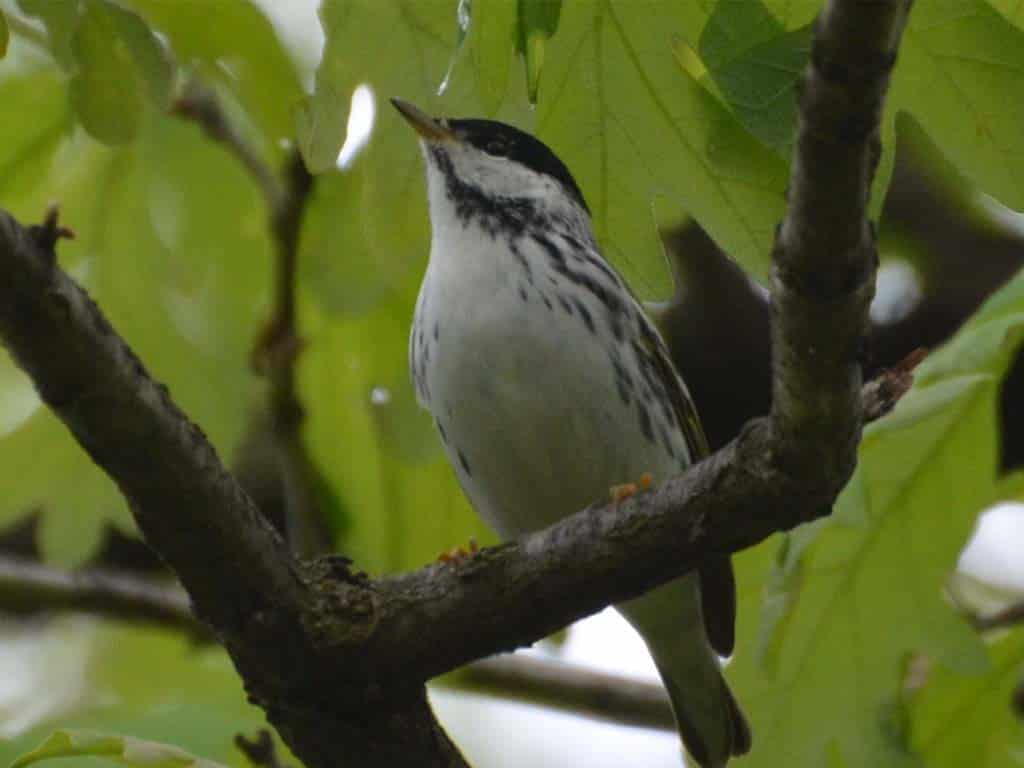
The Blackpoll Warbler is renowned for its incredible long-distance migration and dramatic seasonal plumage changes.
Key Features:
- Length: 5.1-5.5 inches
- Wingspan: 8.3-9.1 inches
- Weight: 0.4-0.5 ounces
Breeding males have a distinctive black cap and white cheeks, with black-and-white striped bodies. Non-breeding birds and females are more subtly colored in olive-green and white.
Incredible Migration: Blackpoll Warblers make one of the longest over-water journeys of any songbird, flying non-stop for up to 88 hours to reach their wintering areas in South America.
Conservation Challenges: Climate change and habitat loss pose significant threats to this species, with populations declining by about 90% since the 1970s.
American Redstart: A Flashy Black Bird with White Belly
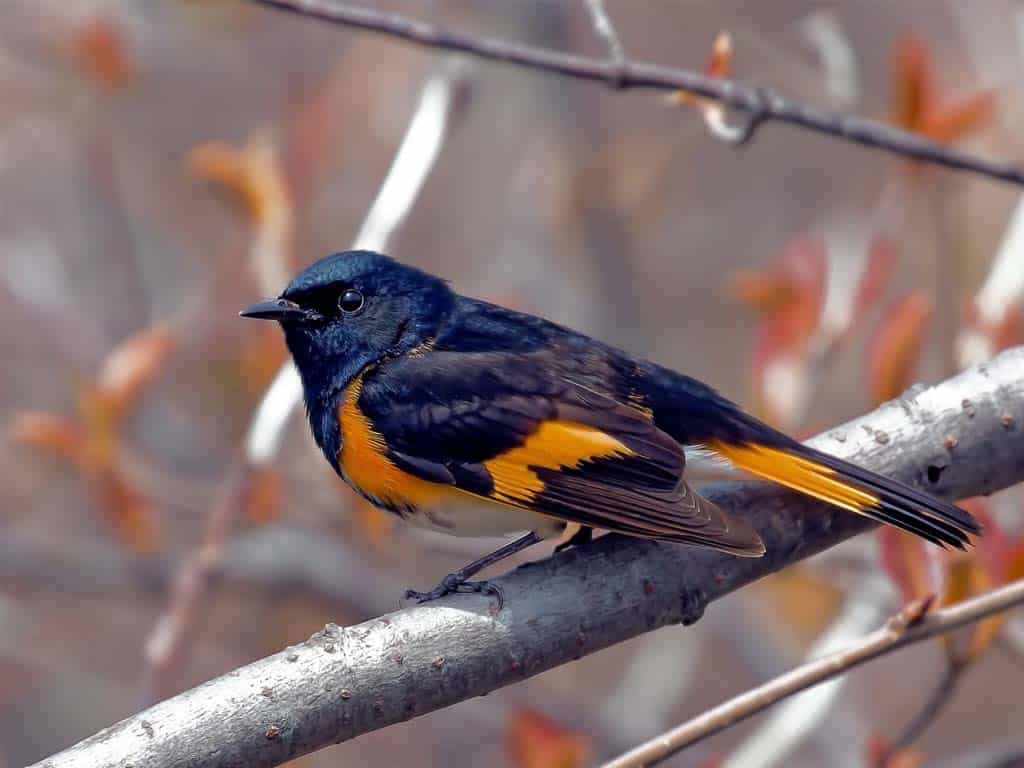
The American Redstart is a flashy warbler known for its distinctive “flycatching” behavior and striking plumage.
Key Features:
- Length: 4.3-5.5 inches
- Wingspan: 6.3-7.5 inches
- Weight: 0.2-0.3 ounces
Male American Redstarts are primarily black with bright orange patches on their wings, tail, and sides. Females replace the black with olive-gray and the orange with yellow.
Flashy “Flycatching” Behavior: These warblers have a unique hunting style, fanning their tails to startle insects into flight before catching them mid-air.
Sexual Dimorphism: The stark difference in coloration between males and females is a prime example of sexual dimorphism in birds.
Check this out Do hawks attack people? why are hawks Aggressive to people?
Identifying Black Birds with White Bellies: Tips and Tricks
Identifying these small black birds with white bellies can be challenging, but here are some key field marks and behaviors to look for:
- Flycatchers:
- Eastern Kingbird: Look for the white band at the tip of the tail
- Black Phoebe: Watch for repeated tail-dipping behavior
- Sparrows:
- Dark-eyed Junco: Note the pink bill and white outer tail feathers
- Harris’s Sparrow: Look for the black bib and crown in adults
- Towhees:
- Eastern Towhee: Listen for the “drink-your-tea” call
- Spotted Towhee: Look for white spots on the wings and back
- Warblers:
- Black-and-white Warbler: Observe its creeping behavior on tree trunks
- Blackpoll Warbler: Look for the distinctive black cap in breeding males
- American Redstart: Watch for its tail-fanning behavior
Remember, patience and practice are key in bird identification. Don’t be discouraged if you can’t immediately identify a bird – even experienced birders sometimes struggle!
Conservation of Black Birds with White Bellies: Protecting Our Feathered Friends
Many of these species face challenges due to habitat loss, climate change, and other human activities. Here’s how you can help:
- Support habitat conservation: Donate to or volunteer with organizations that protect bird habitats.
- Create bird-friendly spaces: Plant native species in your yard and provide water sources.
- Participate in citizen science: Join projects like eBird or the Christmas Bird Count to contribute valuable data.
- Reduce window collisions: Use bird-friendly window treatments to prevent bird strikes.
- Keep cats indoors: Outdoor cats are a major threat to birds.
By taking these steps, you can play a crucial role in protecting these fascinating species for future generations to enjoy.
Check this out Crane Vs Heron – The Complete Comparison
Attracting Black Birds with White Bellies to Your Yard
Want to turn your backyard into a haven for these stunning birds? Here are some tips:
- Provide diverse food sources:
- Sunflower seeds for juncos and towhees
- Suet feeders for warblers
- Native fruit-bearing plants for American Redstarts
- Create a water feature: A birdbath or small pond can attract flycatchers like the Black Phoebe and Eastern Kingbird.
- Plant native species: Choose plants that provide food and shelter for birds native to your area.
- Maintain a variety of habitats: Include open areas, shrubby patches, and trees to cater to different species’ preferences.
- Avoid pesticides: These can harm birds and reduce their insect food sources.
The Role of Black Birds with White Bellies in Ecosystems
These birds play crucial roles in their ecosystems:
- Insect control: Many of these species, especially the flycatchers and warblers, are voracious insectivores, helping to keep insect populations in check.
- Seed dispersal: Sparrows and towhees help spread seeds of various plants as they forage.
- Pollination: Some species, like the American Redstart, may inadvertently pollinate flowers while foraging for nectar or insects.
- Indicator species: The presence or absence of certain bird species can indicate the health of an ecosystem.
- Food web components: These birds serve as prey for larger predators, contributing to the balance of their ecosystems.
Fascinating Behaviors of Black Birds with White Bellies
Each of these species has evolved unique behaviors and adaptations that help them thrive in their environments:
- Aerial acrobatics: The Eastern Kingbird’s agility in flight allows it to catch insects and defend its territory effectively.
- Tail-wagging: The Black Phoebe’s distinctive tail movements may help it flush out insects from vegetation.
- Ground-scratching: Towhees use a two-footed backward scratch to uncover hidden food on the forest floor.
- Tree-creeping: The Black-and-white Warbler’s ability to creep along tree trunks allows it to access food sources other warblers can’t reach.
- Long-distance migration: The Blackpoll Warbler’s incredible non-stop flight over the Atlantic Ocean showcases the amazing endurance of these small birds.
Conclusion: The Marvels of Small Black Birds with White Bellies
From the fierce Eastern Kingbird to the flashy American Redstart, these nine small black birds with white bellies represent just a fraction of the incredible avian diversity in North America. Each species has its own unique adaptations, behaviors, and ecological roles, contributing to the rich tapestry of our natural world.
As you venture out to observe these birds, remember that every sighting is an opportunity to connect with nature and contribute to our understanding of these remarkable creatures. Whether you’re a seasoned birder or just starting out, the world of small black birds with white bellies offers endless fascination and discovery.
So grab your binoculars, head outside, and see how many of these feathered gems you can spot. You might be surprised at the avian wonders waiting just outside your door!
By appreciating and protecting these species, we’re not just preserving individual birds—we’re safeguarding entire ecosystems and the complex web of life they support. Each small black bird with white belly you see is a reminder of the intricate balance of nature and our role in maintaining it for generations to come.

